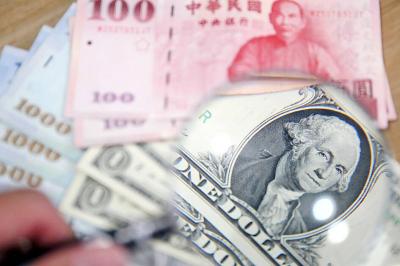Asustek Computer Inc (華碩) yesterday reported slight annual growth in net income for last quarter, supported primarily by better-than-expected notebook shipments during the electronics industry’s peak season.
Net profit inched up 0.88 percent to NT$4.54 billion (US$135.84 million) last quarter, the company said. That represented a quarterly growth of 7.83 percent.
“Last quarter’s net income growth was mainly because of the better-than-expected notebook PC shipments,” chief financial officer Nick Wu (吳長榮) told the Taipei Times.
The PC vendor shipped 5.4 million notebooks during the October-to-December quarter, beating its estimate of 5.2 million units, Asustek said.
The quarterly results brought the company’s net profit for the full year to NT$17.09 billion, down 12.22 percent from NT$19.47 billion in 2014, the company’s filing with the Taiwan Stock Exchange showed.
Asustek attributed the decline to currency exchange losses and lower investment income compared with the previous year.
Brand revenues last year were flattish at NT$436.52 billion compared with NT$436.26 billion in 2014, it said.
Asustek also reported that annual revenue rose 0.9 percent to NT$35.29 billion last month. That represented a sequential decline of 7.08 percent.
The company is to host an investors’ conference tomorrow to provide its quarterly guidance for this quarter.
In related news, Taiwanese contract computer makers Quanta Computer Inc (廣達), Inventec Corp (英業達), Wistron Corp (緯創), Compal Electronics Co (仁寶) and Pegatron Corp (和碩) yesterday all reported double-digit percentage declines in revenue last month due to PC industry headwinds and a seasonal slowdown.
Quanta’s revenue plunged 14.34 percent annually and 38.03 percent monthly to NT$60.07 billion last month, its filing showed.
“Due to early pull-in shipment requests in December and seasonality, Quanta’s notebook shipments plummeted more than 40 percent to 2.3 million units last month from the 4 million notebooks it shipped in a month ago,” an investor relations officer said by telephone.
Wistron’s revenue fell 16.45 percent year-on-year and 29.33 percent month-on-month to NT$41.21 billion last month, while Compal’s dropped 18.41 percent annually and 32.57 percent monthly to NT$56.08 billion last month, citing slow season and clouded visibility of the PC industry.
Pegatron attributed its 14.08 percent annual decline in revenue to NT$101.43 billion last month to a higher base compared with the same period last year.
The slow season also weighed on Pegatron’s sales last month, the company said.
Inventec’s sales shrank 21.9 percent to NT$30.1 billion last month from a month earlier, but the firm’s monthly sales grew 0.78 percent from a year earlier.
“The slight annual increase in revenue was fueled by the robust demand from handheld devices and solar products, while PC shipments last month contracted from a month earlier due to seasonality,” its investor relations officer said.

The US dollar was trading at NT$29.7 at 10am today on the Taipei Foreign Exchange, as the New Taiwan dollar gained NT$1.364 from the previous close last week. The NT dollar continued to rise today, after surging 3.07 percent on Friday. After opening at NT$30.91, the NT dollar gained more than NT$1 in just 15 minutes, briefly passing the NT$30 mark. Before the US Department of the Treasury's semi-annual currency report came out, expectations that the NT dollar would keep rising were already building. The NT dollar on Friday closed at NT$31.064, up by NT$0.953 — a 3.07 percent single-day gain. Today,

‘SHORT TERM’: The local currency would likely remain strong in the near term, driven by anticipated US trade pressure, capital inflows and expectations of a US Fed rate cut The US dollar is expected to fall below NT$30 in the near term, as traders anticipate increased pressure from Washington for Taiwan to allow the New Taiwan dollar to appreciate, Cathay United Bank (國泰世華銀行) chief economist Lin Chi-chao (林啟超) said. Following a sharp drop in the greenback against the NT dollar on Friday, Lin told the Central News Agency that the local currency is likely to remain strong in the short term, driven in part by market psychology surrounding anticipated US policy pressure. On Friday, the US dollar fell NT$0.953, or 3.07 percent, closing at NT$31.064 — its lowest level since Jan.

The New Taiwan dollar and Taiwanese stocks surged on signs that trade tensions between the world’s top two economies might start easing and as US tech earnings boosted the outlook of the nation’s semiconductor exports. The NT dollar strengthened as much as 3.8 percent versus the US dollar to 30.815, the biggest intraday gain since January 2011, closing at NT$31.064. The benchmark TAIEX jumped 2.73 percent to outperform the region’s equity gauges. Outlook for global trade improved after China said it is assessing possible trade talks with the US, providing a boost for the nation’s currency and shares. As the NT dollar

The Financial Supervisory Commission (FSC) yesterday met with some of the nation’s largest insurance companies as a skyrocketing New Taiwan dollar piles pressure on their hundreds of billions of dollars in US bond investments. The commission has asked some life insurance firms, among the biggest Asian holders of US debt, to discuss how the rapidly strengthening NT dollar has impacted their operations, people familiar with the matter said. The meeting took place as the NT dollar jumped as much as 5 percent yesterday, its biggest intraday gain in more than three decades. The local currency surged as exporters rushed to